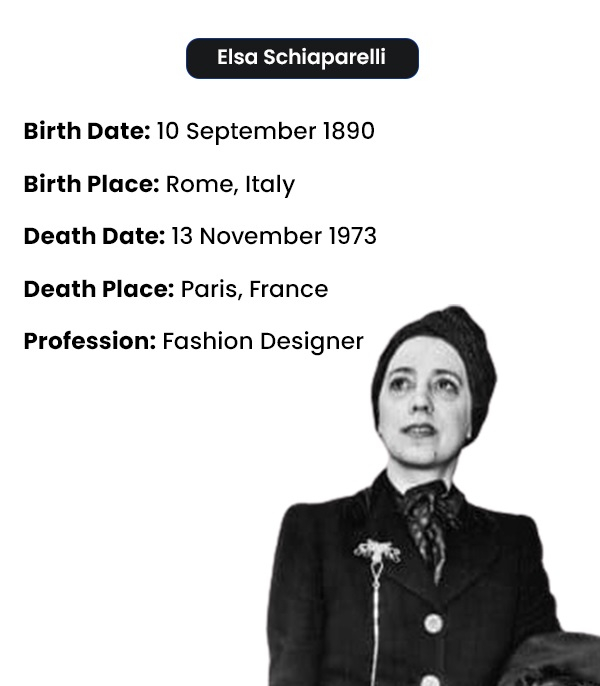

Elsa Schiaparelli was a pioneer who designed several distinctive clothing items and even contributed to the introduction of her trademark hue, Shocking Pink, into the fashion world (Calahan and Zachary). She drew inspiration from her surroundings and considered art and culture while creating clothing, and the Tears dress was no exception. The impact of surrealism on the garment's design was crucial. The trend aimed to "unleash [the] unrestrained imagination" in order to produce fresh and "unexpected" pictures, according to the Metropolitan Museum of Art (Voorhies).

Elsa Schiaparelli was born on September 10, 1890, in Rome, Italy, and passed away on November 13, 1973, in Paris, France. She was well-known for both her funny accessories, like a pocketbook in the form of a telephone, and her surrealist clothing of the 1930s.
Schiaparelli fled her wealthy family and spent a brief period of time working as a translator in America. Later, in the late 1920s, she relocated to Paris and started a fashion company there. She was a pioneer in haute couture by 1935 and was rapidly branching out into jewelry, cologne, cosmetics, lingerie, and swimwear. She was known for fusing quirkiness with simplicity in her designs, as well as trim neatness with flashy color. "Shocking pink," a new color created by Schiaparelli, became the rage in the fashion industry in 1947. In order to mass-produce suits, dresses, and jackets of her design, she fled to New York during World War II and established a branch there in 1949. She had a significant role in the globalization of Parisian fashion, working alongside fashion designer Christian Dior.
Although Elsa Schiaparelli is most recognized for her work from the 1930s, she first gained notoriety for her sportswear designs in the 1920s. She knitted bows and two-dimensional collars into the patterns of her sweaters. Her fashion career was established by these outfits, which also demonstrated her early use of trompe l'oeil design elements. By the middle of the 1930s, Schiaparelli had completely adopted the Surrealist style, which had gained popularity throughout the 1920s. She collaborated with renowned Surrealist designers at this time, producing some of her most distinctive and innovative clothing (Calahan and Zachary).
From 1922 until she was forced to leave the city by political upheaval in the late 1930s, Schiaparelli established her base of operations in Paris. In the middle of this turmoil, Schiaparelli designed one of her most famous collections, which was inspired by the circus. In the summer of 1938, The Circus Collection made its debut to tremendous acclaim. The Parisian fashion audience considered it to be the "most raucous and swaggering collection ever seen. Her many collections are stored in the Victoria and Albert Museum.
Ruth Ford presented the tear dress to the Victoria & Albert Museum after receiving it from Edward James, a supporter of Dal. Ruth Ford was the sister of surrealist poet Charles Henri Ford, in addition to being a model and an actor. She frequently wore Schiaparelli creations, but no pictures of her in the Tears dress have survived. According to a Harper's and Queen piece from the magazine's 1992 edition, Ford and others wore it. During the period, it was common for well-known actresses and socialites to don some of Schiaparelli's most bizarre items. For instance, Wallis Simpson, the Duchess of Windsor, wore the renowned Lobster dress, another creation of Dal. The fact that Ford owns the outfit illustrates how deeply ingrained Schiaparelli was at the time in the Surrealist artistic scene.
One of Elsa Schiaparelli's most well-known creations, the Tears dress, was a part of her spring 1938 "Circus" Collection. Despite having a rather straightforward design, the garment has surrealist qualities that would come to characterize Schiaparelli's work during this decade. The outfit is a floor-length, fitted-at-the-waist sheath dress with no sleeves. The back of the dress has two pointed trains that appear to be trailing behind the wearer. A strap is used to fasten the opposite side over the shoulder. It has a wide bateau neckline and flows gracefully across the chest to the left shoulder, which is gathered. The clothing was initially pale blue, yet it is now ivory because it has been kept in storage for years.
The garment's essential significance lies in its embodiment of the partnership between Elsa Schiaparelli and Salvador Dal, which is in addition to its outstanding inventive use of materials. The dress's name comes from the design, which is repeated throughout and has a distinct "tear" print. The artwork was created by the one and only Dali. F. Then, the pink, magenta, and black printed "tears" that cover the dress are mirrored on the veil. However, the veil features genuine tears that are gently lined with pink and magenta fabric rather than the dress's flat trompe l'oeil design.
This brings us to the conclusion that Schiaparelli's themed collections pioneered a new method for fashion design. For fashion designers, crafting a collection with a theme—especially one as fanciful as the circus—was unheard of at the time, but it has since become standard practice. The "conceptual" collections were held to Schiaparelli's high standards. She created outfits that got increasingly outlandish by drawing influence from various parts of art and society. She is indeed a fashion icon who should be remembered.